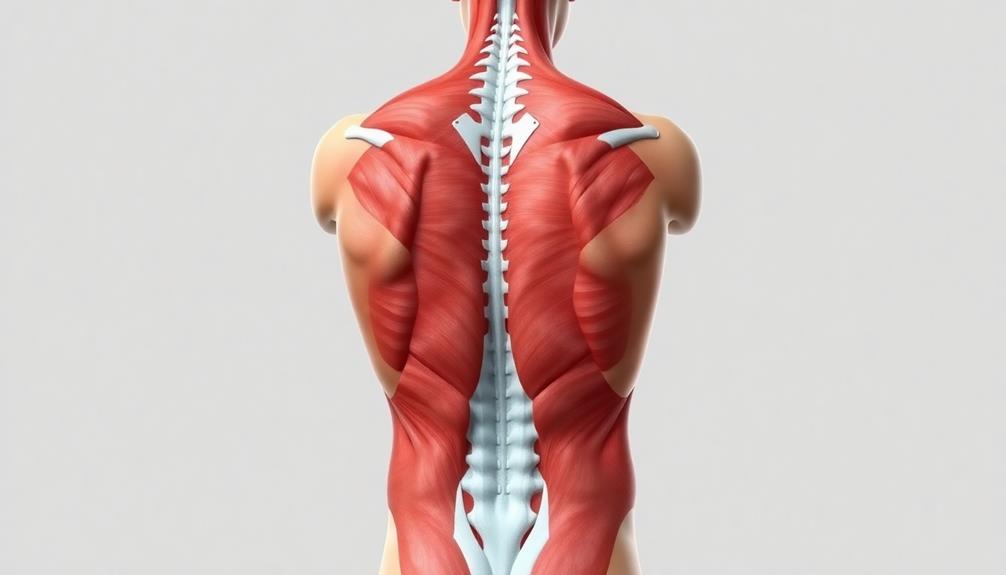To master back hypertrophy, start by understanding the anatomy of your back muscles. Focus on key exercises like pull-ups, rows, and deadlifts, ensuring proper form and technique. Implement progressive overload strategies to continually challenge your muscles, and train your back 2-3 times a week with adequate rest between sessions. Pay attention to nutrition, prioritizing lean proteins and complex carbs. Avoid common mistakes like using momentum or sacrificing form for heavier weights. Track your progress regularly through photos and strength improvements. As you advance, consider incorporating techniques like drop sets or eccentric training. Discover more advanced methods to take your back development to the next level.
Core Insight
- Focus on compound exercises like pull-ups, rows, and deadlifts to target multiple back muscles simultaneously.
- Implement progressive overload by gradually increasing weight, reps, or sets to continually challenge your muscles.
- Maintain proper form and technique, emphasizing controlled movements and full range of motion for optimal muscle activation.
- Train back muscles 2-3 times per week, allowing 48-72 hours of rest between sessions for adequate recovery.
- Incorporate advanced techniques like drop sets, eccentric training, and supersets to stimulate further muscle growth and overcome plateaus.
Understanding Back Muscle Anatomy

To build a strong, sculpted back, you need to understand the muscles that make it up. Your back has several main muscle groups, and each one is important for strength and looking good. Adding exercises for specific muscle groups can make you more flexible, mobile, and better at physical activities.
The lats are the biggest muscles in your back. They give you that V-shape that many people want. Lats help you pull things and extend your shoulders. Your traps go from your neck to the middle of your back. They help move your shoulder blades and keep good posture. The rhomboids are between your shoulder blades and help pull them together.
Don't forget the erector spinae muscles along your spine. They support and straighten your back. The teres major and minor muscles help rotate and stabilize your shoulders. Knowing where these muscles are and what they do will help you target them better when you work out.
Key Exercises for Back Development

Five essential exercises can help you build a strong, muscular back. These exercises work different back muscles, ensuring complete development and strength gains. Here's a simple table showing the main muscles each exercise targets:
| Exercise | Main Muscles Worked |
|---|---|
| Pull-ups | Lats, Lower Traps |
| Bent-over Rows | Middle Back, Lats |
| T-Bar Rows | Middle Back, Lats |
| Seated Cable Rows | Middle Back, Lats |
| Deadlifts | Lower Back, Traps |
Add these exercises to your workouts to develop a powerful, well-shaped back. Use proper form and slowly increase weight and reps over time. Work all back muscles evenly for best results and balance. Mix up these exercises with different variations to keep your muscles challenged and growing.
Proper Form and Technique

Proper form and technique are just as important as mastering the key exercises for building a strong back and avoiding injuries. When doing back exercises, keep your spine neutral and engage your core. For pulling exercises, start by squeezing your shoulder blades together, then pull with your arms. Don't use momentum or swing your body to lift the weight. Using cooling towels during your workout can help you stay comfortable and focused on your form.
When doing rows, keep your chest up and pull the weight to your lower ribs. For lat pulldowns, lean back a bit and pull the bar to your upper chest. When deadlifting, hinge at your hips and keep the bar close to your body. Breathe steadily, exhaling as you lift the weight. Always focus on controlled, full range of motion rather than lifting heavier weights with bad form.
Progressive Overload Strategies

Progressive overload is key to keep building your back muscles and getting stronger. To do this right, start by slowly adding more weight to your lifts. Try to increase the weight a little bit every week or two. But weight isn't the only thing you can change. You can also do more reps or sets, or take shorter breaks between sets. Using foam rollers to massage your muscles can help you stay flexible and recover better, which also helps with progressive overload.
Another trick is to slow down your movements, especially when you're lowering the weight. This makes your muscles work harder for longer. You can also try different versions of exercises. For example, you can switch your grip on pull-ups or do single-arm rows instead of using a barbell. These changes make your muscles work in new ways, helping them grow and get stronger.
Optimal Training Frequency

To build a strong and muscular back, you should train it 2-3 times a week. This gives your muscles enough time to grow and recover between workouts. OnWhey supplements can help your muscles recover and grow faster, so you get the most out of your training.
When making your workout plan, think about:
- How many exercises you do
- How hard you work
- How well you recover
- How long you've been training
If you're new to working out, start with two back workouts per week. As you get stronger, you can add a third workout. Pay attention to your body and change your plan if needed. Some people do better with more workouts that are shorter, while others like fewer workouts that are longer.
No matter how many times you train your back each week, always wait at least 48 hours between back workouts. This rest time is crucial for your muscles to repair themselves and grow bigger.
Nutrition for Back Muscle Growth

Training frequency is just one part of growing your back muscles. The right nutrition is also key. To feed your back muscles well, eat:
- Lean proteins like chicken, fish, and turkey
- Complex carbs such as brown rice and sweet potatoes
- Healthy fats from foods like avocados and nuts
- Leafy greens for vitamins and minerals
- Lots of water to stay hydrated
To recover well, think about adding simple carbs to your post-workout meal. They can help restore energy quickly. Try to eat a meal with protein and carbs within an hour after training. This gets the muscle recovery process going. During the day, eat 300-500 calories more than you need to maintain your weight. This supports muscle growth. Make sure to eat protein at multiple meals. It provides amino acids to repair and build muscle throughout the day.
Recovery and Rest Principles

Your back muscles need proper rest between intense workouts to grow stronger. Wait 48-72 hours before training your back again. This allows time for muscle repair and growth. During this break, aim to get 7-9 hours of quality sleep each night. Sleep helps regulate hormones and recover muscles. Drinking coconut water after workouts can boost hydration and replenish minerals.
On rest days, do light cardio, stretching, or yoga. These improve blood flow and reduce soreness. Don't forget to stay hydrated and eat well, as both are key for muscle recovery.
If you feel very tired or have lasting soreness, listen to your body and adjust your training plan. Overtraining can slow progress and increase injury risk. Make recovery and rest a priority to get the best results for your back muscles and stick with training long-term.
Common Mistakes to Avoid

Proper recovery is key, but you also need to watch out for common mistakes in your back training. Using a foam roller for deep tissue massage can help your muscles recover and prevent injuries. Here are some mistakes to avoid for the best results:
- Don't use momentum instead of controlled movements
- Don't sacrifice good form just to lift heavier weights
- Don't overtrain your back muscles – give them enough rest
- Don't ignore the importance of a balanced workout routine
- Don't forget to gradually increase the intensity of your exercises
Tracking Progress and Results

Tracking your progress is key to staying motivated and making sure your back muscle-building efforts are working. Here are some effective ways to track your results:
- Take progress photos from the front and back every 4-6 weeks.
- Measure your chest, waist, and shoulders once a month.
- Keep a workout journal to record the weights, sets, and reps for each exercise. A foam roller set can help with muscle recovery and flexibility, which can improve your progress.
- Keep track of how much stronger you're getting over time.
- Check for increased definition in your back muscles.
- Use body fat calipers to track changes in your body fat percentage.
- Ask trusted friends or trainers for their thoughts on your progress.
Advanced Back Training Methods

Once you've mastered the basics of back training, take your workouts to the next level with advanced techniques. These methods will challenge your muscles in new ways, helping you build more strength and muscle. Try adding these strategies to your routine:
- Drop sets: Lower the weight after reaching failure and keep doing reps
- Eccentric training: Focus on slow, controlled movements when lowering the weight
- Supersets: Do back exercises back-to-back with little or no rest
- Isometric holds: Hold contracted positions to keep tension on the muscles
- Varied grip widths: Switch between close, medium, and wide grips
Be smart when using these advanced techniques. Pick one or two methods to add to your workouts. Slowly increase how often you use them and how intense they are as your body gets used to it. For the best results, pair these methods with recovery tools like cold therapy wraps to help with soreness and swelling. Always focus on using good form, even when pushing yourself. Adding these advanced techniques will help you keep making progress and overcoming plateaus as you build your back muscles.
Frequently Asked Questions
Can Back Exercises Help Improve Posture?
Yes, back exercises can greatly enhance your posture. They strengthen the muscles that support your spine, helping you maintain proper alignment. You'll stand taller, reduce strain on your neck and shoulders, and feel more confident throughout the day.
Are Resistance Bands Effective for Back Muscle Development?
Yes, resistance bands can be effective for back muscle development. You'll find they're versatile and provide constant tension throughout exercises. They're great for targeting specific muscles and can be used anywhere, making them a convenient training tool.
How Long Does It Typically Take to See Noticeable Back Muscle Growth?
You'll typically see noticeable back muscle growth in 8-12 weeks with consistent training. However, individual results vary based on factors like genetics, diet, and workout intensity. Stay patient and keep pushing yourself for best results.
Can Back Training Help Alleviate Lower Back Pain?
Yes, back training can help alleviate lower back pain. You'll strengthen core muscles, improve posture, and increase flexibility. It is crucial to use proper form and start with light weights. Always consult a doctor before starting any exercise program.
Are Genetics a Significant Factor in Achieving an Impressive Back Physique?
Yes, genetics play a role in your back's potential, but don't let that discourage you. With consistent training, proper nutrition, and smart exercise selection, you can greatly enhance your back's appearance and strength regardless of your genetic predisposition.

